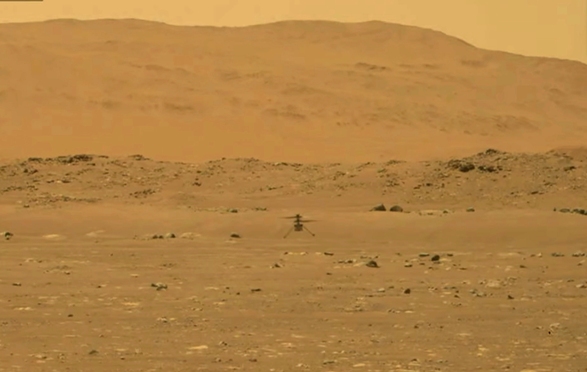NASA’s Mars helicopter completes first flight on another planet

By Kenneth Chang
A small robotic helicopter named Ingenuity made space exploration history on Monday (19) when it lifted off the surface of Mars and hovered. It was the first machine from Earth ever to fly like an airplane or a helicopter on another world.
The achievement extends NASA’s long, exceptional record of firsts on Mars.
“We together flew at Mars,” MiMi Aung, the project manager for Ingenuity, said to her team during the celebration. “And we together now have this Wright brothers moment.”
Like the first flight of an airplane by Wilbur and Orville Wright in 1903, the flight did not go far or last long, but it showed what could be done. Flying in the thin atmosphere of Mars was a particularly tricky technical endeavour, on the edge of impossible because there is almost no air to push against. NASA engineers employed ultra-light materials, fast-spinning blades and high-powered computer processing to get Ingenuity off the ground and keep it from immediately veering off and crashing.
And just as the Wright plane led to a transformation in how people and goods zip around Earth, Ingenuity offers a new mode of transportation that NASA can now use as it studies the solar system’s mysteries. Future robotic explorers, with this technology under the agency’s belt may take new, unconventional shapes.
Ingenuity was also something different for NASA — a high-risk, high-reward project with a modest price tag where failure was an acceptable outcome.
That approach is more similar to that of nimble space companies like SpaceX than large traditional development programs that work through every possible contingency to build a full-scale machine that has to work the first time.
Ingenuity was thus a small experiment tacked onto NASA’s Mars rover, Perseverance, but it has the potential for a paradigm-breaking advance.
Perhaps a more advanced helicopter could serve as a scout for a future rover, identifying intriguing locations for closer study and safe routes for the rover to drive there. Or swarms of helicopters could zip up and down cliff faces to examine layers of rock that are too far away or out of view of current spacecraft.
On Sunday (18), mission controllers at NASA’s Jet Propulsion Laboratory in California radioed the commands for the test to Perseverance, which landed on Mars in February. Perseverance in turn relayed the commands to Ingenuity, which was sitting 200 feet away on flat terrain that was chosen to serve as the airstrip for a series of five test flights.
At 3:34 a.m. Eastern time — it was the middle of the Martian day, half an hour past noon — the helicopter spun up its rotors as it had been commanded and rose above Jezero crater, into the Martian sky.
At the surface of Mars, the atmosphere is just 1/100th as dense as Earth’s, not much for helicopter blades to push against. Thus, to generate enough lift for the 4-pound Ingenuity to rise up, its two rotors, each about 4 feet wide, had to spin in opposite directions at more than 2,500 revolutions per minute.
It hovered at a height of some 10 feet for 30 seconds. Then it descended back to the surface.
But at that moment, no one on Earth — including people at NASA — knew what was actually happening. The two spacecraft were not in communication with Earth during the test, and Ingenuity had to perform all of its actions autonomously.
It was only three hours later that one of NASA’s other Mars spacecraft, the Mars Reconnaissance Orbiter, passed overhead, and Perseverance could relay the test data gathered from the flight through the orbiter back to Earth.
Minutes later, engineers analyzed the data that showed a successful flight.
Havard Grip, the engineer who serves as NASA’s chief pilot for Ingenuity, announced as the data arrived that “the first powered flight of a powered aircraft on another planet.”
Soon after, engineers displayed a picture taken by Ingenuity in flight showing its shadow on the ground and then a video by Perseverance of the helicopter hovering in the air.
Aung told her team to celebrate the moment. “And then after that, let’s get back to work and more flights,” she said.
With Monday’s success, up to four more flights could be attempted. The first three are designed to test basic abilities of the helicopter. The third flight could fly a distance of 160 feet and then return. The final two flights could travel farther, but NASA officials did not want to speculate how much farther.
NASA plans to wrap up the tests within 30 Martian days of when Ingenuity was dropped off on April 3 so that Perseverance can commence the main portion of its $2.7 billion mission. It will leave the helicopter behind and head toward a river delta along the rim of Jezero crater where sediments, and perhaps chemical hints of ancient life, are preserved.
Ingenuity was an $85 million nice-to-have, add-on project, but not a core requirement for the success of Perseverance.
The looser requirements of a technology demonstration allowed the engineers to use an almost off-the-shelf Qualcomm processor that was originally developed for cellphones with more computing power than all previous interplanetary spacecraft combined.
The processor, which was not adapted for the harsh conditions of space, was more susceptible to disruptions of radiation, but the helicopter needed all of that number-crunching speed to maintain steady flight.
-New York Times

